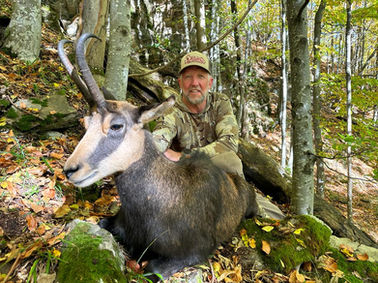CHAMOIS
The name chamois comes from the French word for goat and belongs to the goat family. Chamois are also sometimes
referred to as goat antelopes. It weighs approximately 35-50 kilograms (77-110 lbs) with maximum weight among male specimens of 60 kg (132 lbs).
Balkan Chamois (Rupicapra Balcanica), a type of chamois, is widely spread across all Balkan countries –Croatia, Serbia, Bosnia, Macedonia, Bulgaria, Albania and Greece - and its largest concentration can be found in Macedonia. It typically dwells on altitudes over 2,000 meters (6,560 ft.) but is known to climb down to places lower than 1,000 m (3,280 ft.), particularly during winter as well as at times when evading predators. It is a beautiful animal and also considered a fantastic hunt among European hunters.
Its hunting season begins in August and ends in January. Both male and female specimens can be hunted. Rutting season is in October and the beginning of November – this period is considered as the best time frame for hunting. Shooting distance is between 150 and 300 m and it is recommended to shoot using 243, 6.5, 270, 308, 7 mag and 300 win mag calibers.
In Macedonia, Balkan chamois hunts are most successful on two places: mountains Karadzica and Mavrovo. In addition, it is
present in several other places – Sar, Galicica, Pelister, Kozuf, etc., but in smaller numbers. Its trophy value is quite high and typically places around 100 CIC points and above.
The hunt itself requires moderate physical preparation and good mountain hunting gear. We recommend warm and light clothing as well as mountain boots with great traction. We adjust all chamois hunts based on the hunter’s physical condition and age. Therefore, all hunters have an opportunity to get an excellent trophy. Hunters are accommodated at the lodge on the same hunting grounds. The altitude is about 1,600 m (4,600 ft.). Great food, clean air and good Macedonian wine is our signature accommodation.

Carpathian chamois (rupicapra rupicapra carpatica) are hunted solely in Romania. They are present all along the Carpathian Mountain range, hence the name of the type of chamois. The chamois population is in abundance and their trophy quality is very high, thereby making the Carpathian chamois one of the largest types of chamois among the species in Europe and Asia. The hunt takes place on an altitude of about 3,000 ft (1,000 m) which makes the hunt appealing for hunters of all ages and conditions. In addition, the weather conditions are not considered to be extreme.
The hunting season is from September 15 to December 15.

The population of Alpine chamois is considered to be one of the most thriving in Europe. In addition, it is known for its high trophy quality. Our company organizes Alpine chamois hunts in several regions in Slovenia, among which the best are the tri-state area between Italy, Slovenia and Austria, on the Julian Alps as well as Central Slovenia, near the Kamnik region. The selection of hunting location depends on the weather conditions and the physical condition of the hunter.
The season starts on September 1 and ends on December 31. Average altitude of the hunt is between 4,500 and 7,500 feet (1,500 - 2,500 m). The shooting distance is between 200 and 300 yards and we recommend the following calibers: 270, 308, 7 mag, 300 win mag.

Tatra chamois is The Tatra chamois (Rupicapra rupicapra tatrica; Slovak: Kamzík vrchovský tatranský; Polish: Kozica tatrzańska) is a subspecies of the chamois of the genus Rupicapra. The Tatra chamois live in all parts of the Tatras: West Tatras (Slovakia and Poland) and Eastern Tatras, which consist of the High Tatras (Slovakia and Poland) and the Belianske Tatras (Slovakia), all protected by national parks in both countries.
The population has undergone several troughs and peaks in known history, with the most noticeable troughs occurring during both world wars. The largest population in the 20th century was recorded in the year 1964, when as much as 940 individuals were counted in the Slovak region of the Tatras. Subsequently, the population declined steadily to the lowest recorded numbers in history at the end of the century. During the years 1999-2000 numbers dropped below 200 individuals, which is considered a critical population size for the long-term survival of the subspecies.
The season starts on November 1 and ends on December 31. Average altitude of the hunt is between 1,800 and 3,000 feet (600 m - 1,000 m). The shooting distance is between 100 and 300 yards and we recommend the following calibers: 243, 270, 7mm.








































